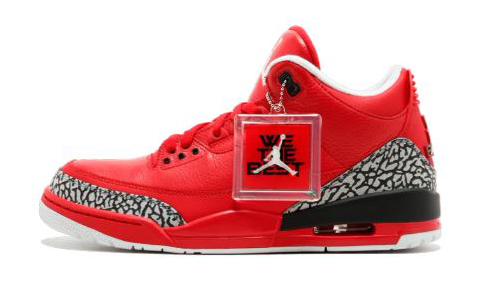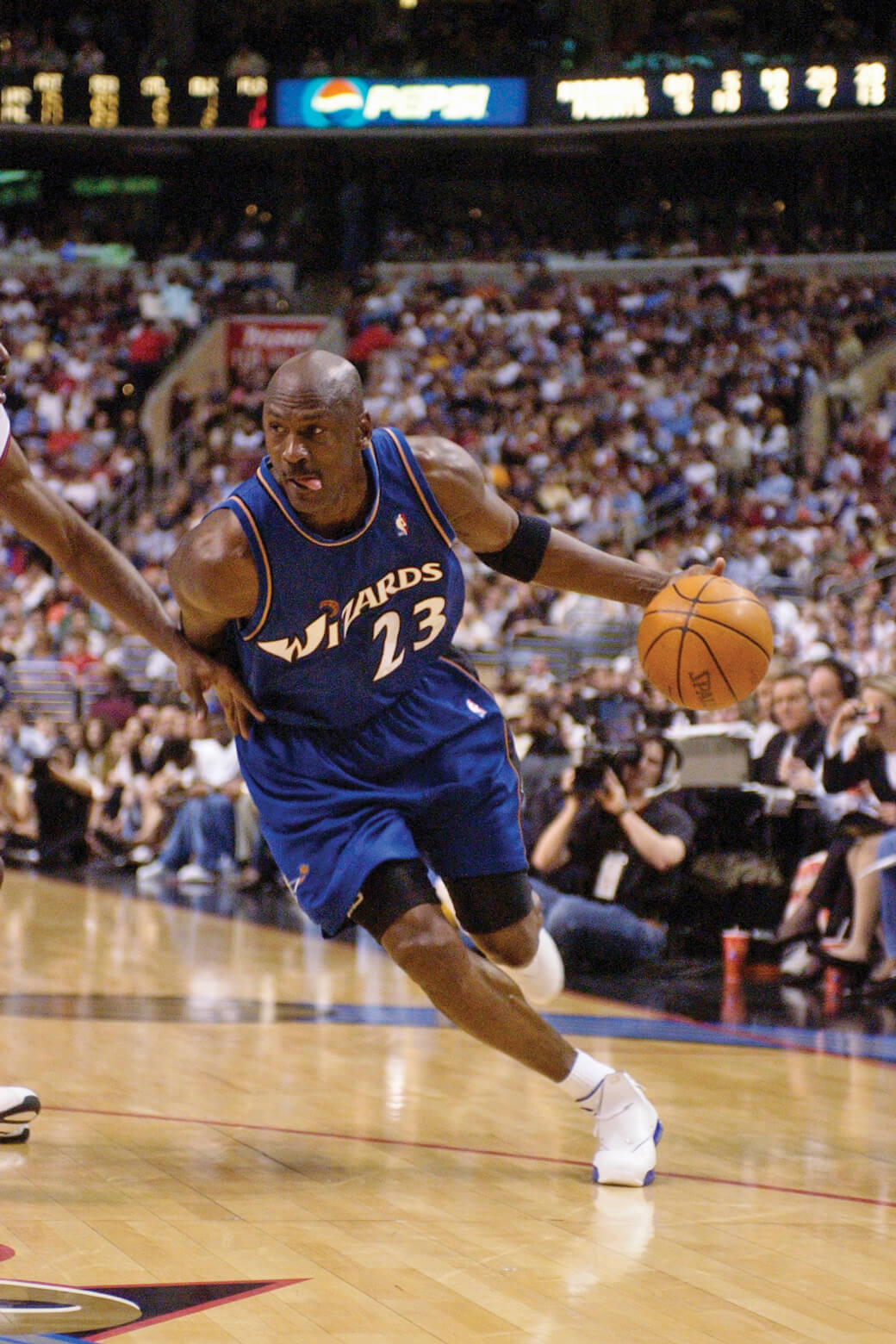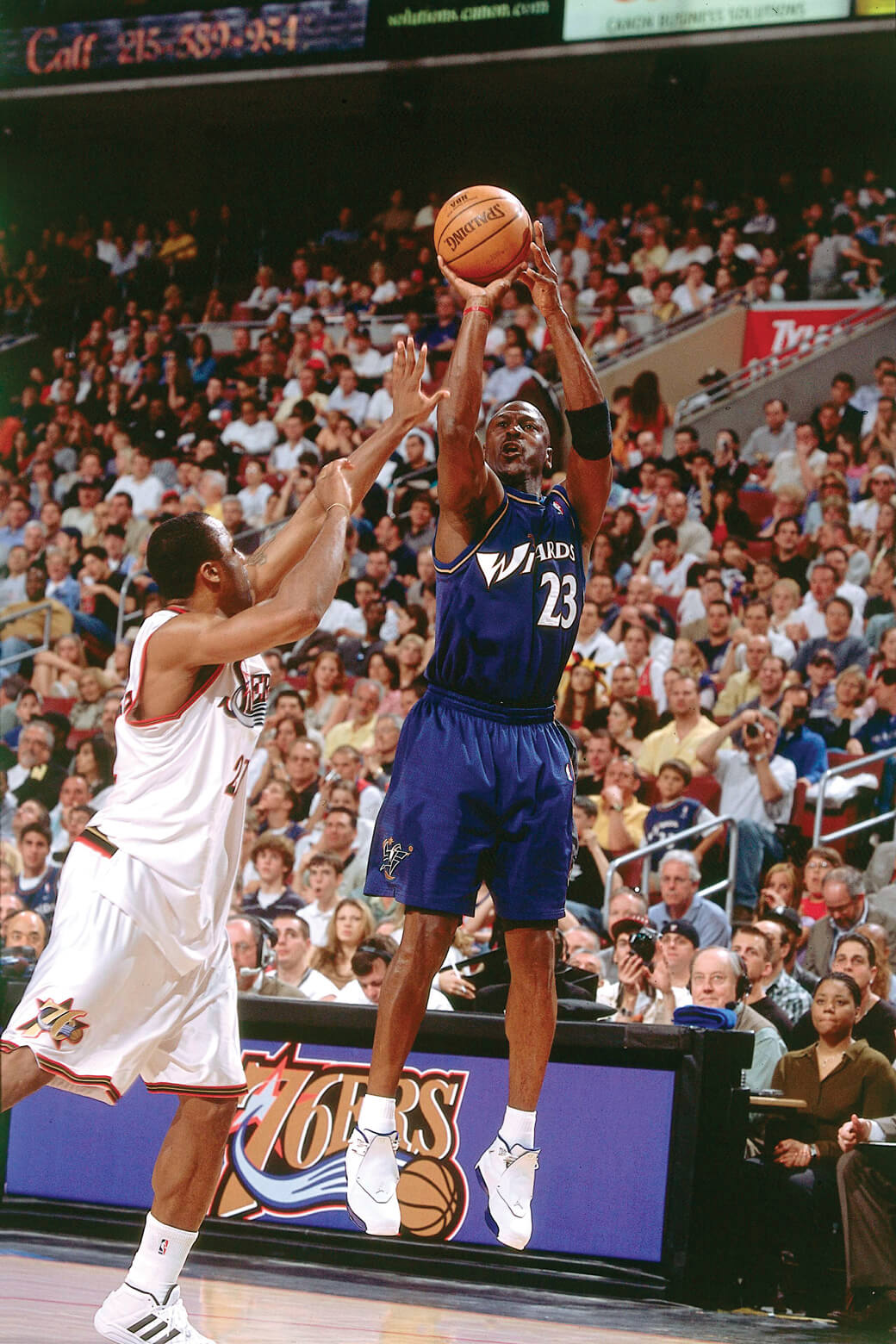GRAB YOUR COPY OF SLAM PRESENTS JORDAN HERE
He was done. The lasting image of “The Last Shot” was the perfect exclamation point to Michael Jordan’s legacy. The greatest player to ever pick up a basketball had ended his NBA career on the highest possible note any player could.
Thing about Mike, though. He had this itch.
A year after his second retirement from the League, Jordan popped up as a minority owner and president of basketball operations for the Washington Wizards. As a front office exec, Michael was tasked with putting together a roster, managing the cap, making draft picks and whatever other paper-pushing the guys in suits do up there in the owner’s box. But every morning, he’d make his way down to the locker room or the trainer’s tables with his coffee. He’d chat with vets like Popeye Jones and Hubert Davis, shoot the shit. He was itching.
In September 2001, two weeks after the 9/11 attacks shook the nation’s capital, Jordan announced his intention to return to the hardwood after three seasons away. He divested his ownership stake in the team and showed up at Wizards media day as a 38-year-old player.
“It’s an itch that still needs to be scratched here and I want to make sure this scratch doesn’t bother me for the rest of my life,” he told the assembled reporters at the MCI Center. “What if I’m tired of playing in the YMCA and the Boys & Girls Club and I want to step up to the elite competition?
“I’m just going to play the game of basketball that I love. I’m not about the money. I don’t care if I get paid a dime,” Mike continued. “I’m going to play the game because I love it.” (And yes, Jordan’s track record as a Wizards executive is well-documented. Just a few months prior, he’d famously selected Kwame Brown straight out of high school with the No. 1 overall pick in the 2001 Draft, a decision that can only really be described as a huge misfire. But let’s separate Jordan the player from Jordan the GM, at least for a few hundred words, shall we?)
Doug Collins, who’d previously coached Michael in Chicago, was installed as the Wizards’ head coach and Washington held training camp in Jordan’s hometown that October, at the University of North Carolina-Wilmington. Outside of Mike and budding star Richard Hamilton, the Wizards came into the ’01-02 season with a funky mélange of promising young talent and steady, if plodding, veterans. For everyone on the roster, those first few practices with Jordan were surreal. “He would get the ball and we would all just stand around and watch,” recalls Jones. “Whether I was on his team or not.”
Off the court, traveling with Michael Jordan also took some getting used to, as his god-like status precipitated a rockstar lifestyle on the road for an otherwise humdrum Wizards team. Then-rookie center Etan Thomas remembers fans who would fight through crowds just for a high-five from Jordan, then look at their hand like it was made of solid gold. “It was like traveling with Michael Jackson or something,” says Thomas. “I saw people look at him and just start crying, craziest thing I’ve ever seen.”
Jordan’s personal trainer, Tim Grover, traveled with the Wizards on the road, too. Every morning at 7 a.m., they’d find a health club near the team hotel to go work out, like clockwork. Every morning. Every city. Every practice. He was no longer doing it with the iconic black-and-red Bulls gear on his back, but as Davis puts it: “He was Michael.”
Davis and Jordan both played at UNC (where Davis is now an assistant coach) and had competed in heated Bulls-Knicks playoff battles during the ’90s. But seeing the daily work ethic, preparation and competitiveness up close was something different. Davis remembers his jumper catching fire one day in practice when the two were paired up on the same team.
“I was practicing really well, I was hitting everything. So Michael switched jerseys and went to the other team and he guarded me. For the rest of the practice, not only did I not score, I didn’t even get a shot off,” Davis says. “I just was like, What is wrong with you? We’re on the same team! You’re that competitive that you want to compete against me? I’m a role player. You’re the best that’s ever played. He said, This is no different than playing in Game 7 of the NBA Finals—competing is competing. Some people turn it off and turn it on. For him, he never turned it off.”
Jones, now an assistant with the Indiana Pacers, recalls a practice later on during the 2001-02 season when MJ was scoring so easily—looking like Prime Chicago Bulls MJ—that Collins stopped the scrimmage and instructed him not to shoot anymore.
“We started scrimmaging again,” Jones explains, “and Michael had the same aggression he usually had scoring the ball, but he looked like John Stockton or Magic Johnson. I was astonished that he had that kind of vision. He was still attacking, but he wouldn’t shoot—he was kicking it out for threes or dropping it off to the bigs in the paint for dunks and layups. I remember after practice saying to him, I had no idea you could pass that way. He just looked at me and said, Oh, I can pass. I see everything. I just want to score.”
And score he did. If you thought it would take Mike a few games to shake the rust off, you must be forgetting who we’re talking about here.
“I think it was one of our first preseason games, we were playing down in Miami,” Jones says. “We’re in the tunnel getting ready to come out, and he says, ‘I’m gonna show you boys how to get 20 points in a quarter and then I’m gonna go sit down.’ At the end of the first quarter, he had 18 points.”
When the regular season started, Jordan delivered six 30-plus point performances before the calendar flipped to December. Then he hung 51 on Charlotte and 45 on New Jersey in back-to-back games in December. Then 40 and 41 against Cleveland and Phoenix in back-to-back outings in January.
Pause for a second. Remember, this man is almost 40 years old. Out here dropping 40-and-50-burgers in back-to-back games in the National Basketball Association. Absolutely unstoppable. Dudes don’t do this. Ever. It cannot be done.
Bobby Simmons, a rookie second-rounder on the Wizards that season, says Jordan was like “a magician.”
Jordan was legitimately in the MVP conversation for a fleeting few weeks as the All-Star break approached. Hell, he had the Wizards hovering above .500 after winning just 19 games the year before. But a knee injury that required surgery effectively ended his season early. Playing in 60 games, Jordan averaged 22.9 points, 5.7 rebounds, 5.2 assists and 1.4 steals per game, playing 35 minutes a night. MJ led the Wizards in scoring and made the Eastern Conference All-Star team. At that point in the season, Kobe Bryant was the only other player in the League averaging 25, 5 and 5.
“The year that I played with him with the Wizards, he dominated every practice and he dominated in every game,” says Davis. “It didn’t matter if we were playing Philadelphia with Allen Iverson, or the Los Angeles Lakers with Kobe and Shaq. Every game that I played with the Wizards with Michael—there wasn’t a game when he wasn’t the best player on the floor. We just didn’t have a very good team.”
The Wizards flipped Davis, Simmons and Hamilton for Pistons All-Star Jerry Stackhouse during the summer of 2002, and added swingman Larry Hughes in free agency. Jordan scored 40 or more points three times in that second Wizards season, becoming the first 40-year-old in League history to score 40+ in a game. He played in all 82 games, averaging 20 ppg and 6 rpg, but the Wizards failed to make the playoffs again, and it became clear that Mike’s knees wouldn’t hold up much longer.
Vince Carter gifted Jordan his starting spot in the 2003 All-Star Game, which morphed into a full-on celebration of MJ’s legendary career (shouts to Mariah Carey’s classic halftime show performance). Fittingly, he even hit an iconic clutch fadeaway jumper late in the game, too.
At his first press conference as a player in Washington, Mike had said he wanted to lock horns with the next generation of elite NBA players: “You say the young dogs are going to chase me around? Well, I’m not going to bark too far away from them either. I’m not running from nobody. If anything, it’ll be a great challenge for me. I’m not saying I can take Kobe Bryant, or I can take Tracy McGrady. You guys are the ones saying they can take me. All good and fine. I’m pretty sure they’re sitting back and welcome the challenge. Guess what, I’m sitting back and welcome the challenge, too.”
Set aside all the other bullshit, the revisionist history, the unraveling of whatever half-hearted Wizards rebuild was in progress, and that’s what Mike’s Wizards comeback was all about, at its core. Did he prove he was up to the challenge? Shaq said, “He still has it.” Paul Pierce said, “Jordan at this age is better than about 90 percent of the players today.”
The unfolding of Jordan’s second un-retirement doesn’t hold iconic status like his “I’m back” fax in 1995, or come with the hardware of his first dramatic return to the court. Without question, those two seasons in Washington will forever serve as curious punctuation to the most legendary career in NBA history. Mike’s longtime agent David Falk says that at the time, he didn’t want MJ to come back: “I just didn’t think it was a good dessert to a great meal.” It was a sentiment shared by many friends and fans. But the more years that pass, the easier it is to forget just how much of a killer Michael Jordan still was on the court, even at 40 years old.
—
GRAB YOUR COPY OF SLAM PRESENTS JORDAN HERE
Abe Schwadron is a social editor at FanDuel and former Senior Editor at SLAM.
Photos via Getty.



